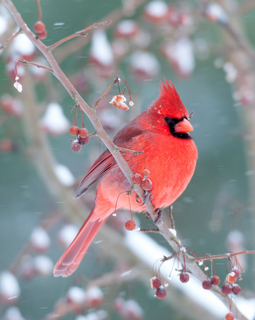Imagine it’s a cold day in winter; snow covers the ground and a bitter wind is blowing. You’re outside in bare feet, searching for food to give you the energy to make it through the below-zero night ahead. No full refrigerator or warm bed beckons; all you have is a down jacket for to ward off the cold. Welcome to the world of a bird in winter in much of the United States!

Winter is a great time to observe and study birds as they visit feeders or plants in the landscape and to learn about birds’ life cycle, biology, and ecology. It’s also a good time to take stock of the schoolyard landscape and come up with a plan to increase its bird-friendliness when spring planting time comes around.
Who Are the Winter Birds?
Discovering what birds you and your students are likely to see in the winter, both visiting feeders and out in the landscape, is a good starting point. The species encountered will depend on where you are in the country and the kind of habitats your schoolyard and nearby areas offer. Many birds migrate to milder winter areas where food and shelter resources are more plentiful. If your school is located in a southern state, you may see avian visitors such as cedar waxwings during the winter that have migrated from areas farther north and to which they’ll return in spring to breed and raise their young. Other birds like hummingbirds and chimney swifts fly as far as Central and South America for the winter and won’t reappear in our landscapes until spring. Some birds, including house sparrows, chickadees, cardinals, and blue jays, stay put and remain in the same area throughout the year, even in the coldest northern regions.
Some species that you’re likely to see visiting bird feeders or foraging in the
Have students keep track of the different species and their numbers visiting feeders and or dining on plants in the landscape. Do some kinds of birds prefer to eat certain kinds of foods at feeders or growing naturally? Do the kinds and numbers of birds visiting feeders or observed in the landscape change over time? Do changes in the weather correlate with changes in bird numbers or behavior? Each student can create a bird journal with drawings, observations, and information about the birds he or she sees.
Consider participating as a class in the Great Backyard Bird Count (GBBC). A project of the Cornell Lab of Ornithology and National Audubon Society, the GBBC is an annual four-day event that engages bird watchers of all ages in counting birds to create a real-time snapshot of bird populations. Participants are asked to count birds for as little as 15 minutes (or as long as they wish) on one or more days of the event and report their sightings online. The next GBBC will be held on Friday, February 13, through Monday, February 16, 2015. For more information, visit www.birdcount.org.
Amazing Adaptations
Birds have some clever adaptations that help them to survive the winter
You’ve never seen a bird wearing warm winter boots, so why don’t its featherless feet and legs freeze? This is due to one of the bird’s most interesting adaptations, called counter-current blood circulation. Warm arterial blood headed from the heart to a bird’s foot passes via an intertwined network close to the cold blood that is getting returned from the feet to the heart in the veins. The cold returning venous blood picks up heat from the arterial blood, with the result that the arterial blood reaching the foot is relatively cold, reducing the heat loss from the exposed foot. Since birds’ legs and feet are mostly tendons they don’t need a great deal of warmth, so this circulatory adaptation allows birds to conserve heat by keeping their feet just warm enough to avoid frostbite.
What Birds Need
Even with the help of these winter survival adaptations, birds must find a steady supply of high energy food to give them with the fuel they need to maintain their body temperature (which is often higher than ours!) They also need places that offer shelter from wind, rain, and snow and protection from predators. This is where we humans can help them out. We can fill our cultivated landscapes with plants that provide a bird banquet of seeds, fruits, and nuts through the winter months. We can also put foods like seeds and suet out in bird feeders to supplement what the landscape provides. We can include plants such as evergreens or densely branched deciduous shrubs to provide cover as well.
Create a Bird-Friendly Landscape Plan
Have students do an inventory of existing plants on school grounds. What plants do they find that provide winter food for birds? Are there areas on 
- Birds appreciate a food source at any time of the year, so try to include plants that fruit in both summer and fall. But with winter food in mind, be sure to select some with fruits that persist through the winter. These will not only feed birds during the winter but will help to nourish migrant birds returning in early spring when other food sources are still scarce. Some widely adapted plants with berries that persist into the winter include crabapple, snowberry (Symphoricarpos), American bittersweet, sumac, viburnum species such as nannyberry (V. lentago), arrowwood (V.dentatum) and blackhaw (V. prunifolium), chokeberry (Aronia), beautyberry (Callicarpa), bayberry, Virginia creeper (Parthenocissus quinquefolia), and deciduous and evergreen hollies (Ilex species). Acorn and nut-producing trees like oaks, hickories, and beech will also feed birds like jays and woodpeckers.
- Select primarily native plants adapted to the conditions at your site. While the fruits of some non-natives are enjoyed by birds, native plants have evolved along with the birds and are more likely to provide the best, most digestible nutrition for them.
Leave seed heads from plants like goldenrod and coneflower (pictured here) for birds.Leave seedheads standing in the garden over the winter. The dried seedheads of flowering perennials like black-eyed Susan (Rudbeckia) and purple coneflower (Echinacea) are Mother Nature’s birdfeeders. Colorful black and yellow goldfinches and other seed-eaters will happily dine on the seeds of these and other flowers, including sunflowers, cosmos, zinnias, asters, goldenrod, and ornamental grasses.
- Set up a birdfeeder where students can easily observe the birds that come to eat. Place it about 10 feet from plants such as evergreens or dense shrubs that can provide birds with easily accessible cover from predators. But don’t place the feeder closer than 10 feet to avoid giving neighborhood cats a hiding place from which they can wait to ambush visiting birds. Set up the feeder either within 3 feet of windows or more than 30 feet away from them. Close placement keeps birds taking off from feeders from gathering enough speed to be harmed if they do crash into a window, while placing feeders at least 30 feet away reduces the likelihood that they’ll have a collision.
- Have students research the best kinds of feeders and food for the bird species that are likely to visit your feeders. Do some kinds of birds prefer certain kinds of food? Black oil sunflower seeds provide lots of energy and are enjoyed by many species of birds; goldfinches relish small black nyger (also called thistle) seeds; and woodpeckers will make a beeline to suet feeders. Some birds, such as song sparrows and towhees, rarely perch on elevated feeders, preferring to eat seeds on the ground or a flat low platform feeder. Find more bird feeder basics.
- Build birdfeeders as a classroom project. These can be as simple as feeders made from recycled milk cartons to ones made from wood or other durable materials. Kits are readily available or check online for plans.
- Grow sunflowers in your school garden. Leave the plants standing as natural birdfeeders or harvest and store the seeds to put out in your own feeders during the winter.
- To provide cover, choose a diversity of plants, both evergreen and deciduous, and of varying heights from small trees down to small shrubs and groundcovers. Even better, let an out-of-the-way area grow into a dense thicket.



